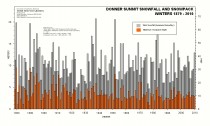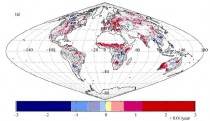Mar 28, 2011
Record Snow Season in Sierra - Nearing 200% of normal at Boreal Ski resort
It is called “Miracle March 2011” in the Sierra. At Boreal, near Donner Summit, as of a few days ago, they had received 221 inches this March bringing the seasonal snowfall to 766 inches. The previous record was 662 inches in 1994/95. The recent prolonged storm brought 6-7 feet of snow. The normal for the season is around 400 inches. Their snowbase is between 275 and 375 inches (20-30 feet).

The Snow Water Equivalent is well above normal and bodes well for both agriculture and coastal cities which rely on the melting snow for irrigation and drinking water. There have been battles for decades over how much water the farmers should get to use in the long dry growing season.

Enlarged.
This wet season has brought over 80 inches of water equivalent to some of the higher terrain.

Enlarged.
Here is the snowfall graph for Donner Summit Central Sierra Snowlab since 1879. It is not the same location as Boreal Ski resort at Donner Summit. But if the numbers are close, Boreal has had 63.8 feet so far, most since 1950/51 La Nina winter (like this year early in a new cold PDO phase).

Enlarged.
Mar 25, 2011
Andrew Bolt interview of Climate Commissioner Tim Flannery exposes the futility of carbon control
By Andrew Bolt, MTR Today
Note from Dr. Bob Carter:
For 3 years we have been trying to get a media reporter to take up the challenge of demanding answers to the two most obvious questions with regards a carbon dioxide tax, which are: 1. What will it cost per family per year; and 2. How much will it reduce temperature by?
About 2 weeks ago, at last, a major journalist latched on to the power of these questions. His name is Andrew Bolt, and this description of his interview with new Australian Climate Commissioner, the admission that anything we do to cut emissions will have no effect for 1,000 years, and the ensuing blog comments, is must reading. More than any other single event in the last few years, this interview has the potential to shatter the idea of carbon dioxide taxation in Australia for once and for all.
Of course, that will only happen if the mainstream media deign to notice, take it up and pursue Flannery, Garnaut and the government over it. My bet is that they are going to try to ignore it, but will be forced by outraged public opinion to address the matter. At which point, it may very well be game, set and match in Australia.
-------
Bolt: How much will it cost to cut our emissions by the Government’s target of 5 per cent by 2020 and how much will world temperatures fall by as a consequence?
Flannery: Sure. We do have economists on the commission who will be giving a very in depth look at that this evening and I don’t want to pre-empt their assessment of the various cost options, but in terms of how much it will cut temperatures that really very much depends upon how Australia’s position is seen overseas.
Bolt: No, no, we’ll get onto that, Tim. I’m not going to dodge that. The argument is indeed that we have to set a lead and the world has to follow and on our own we can’t do blah blah, but just looking at the basic facts so people can figure it out for themselves (that) the world needs to come on board. On our own, cutting our emissions by 5 per cent by 2020, what will that lower the world’s temperatures by?
Flannery: See, that’s a bogus question because nothing is in isolation
Bolt: Everyone understands that that is the argument But we’re just trying to get basic facts, without worrying about the consequences - about what those facts may lead people to think. On our own, by cutting our emissions, because it’s a heavy price to pay, by 5 per cent by 2020, what will the world’s temperatures fall by as a consequence?
Flannery: Look, it will be a very, very small increment.
Bolt: Have you got a number? I mean, there must be some numbers.
Flannery: I just need to clarify in terms of the climate context for you. If we cut emissions today, global temperatures are not likely to drop for about a thousand years. This quote earns the Quote of the Millennium designation from WUWT
Bolt: Right, but I just want to get to this very basic fact, because I’m finding it really curious that no one has got (this) fact. If I buy a car… I want to know how much it costs and whether it is going to do the job.
Flannery: Sure.
Bolt: In this case I want to know the cost of cutting our emissions by 5 per cent by 2020 and will it do the job: how much will the world’s temperatures fall by if Australia cuts its emissions by this much.
Flannery: Look, as I said it will be a very, very small increment.
Bolt: Can you give us a rough figure? A rough figure.
Flannery: Sorry, I can’t because it’s a very complex system and we’re dealing with probabilities here.
Bolt: I’m just trying to get the facts in front of the public so we know what we’re doing. Just unbiased. Is it about, I don’t know, are you talking about a thousandth of a degree? A hundredth of a degree? What sort of rough figure?
Flannery: Just let me finish and say this. If the world as a whole cut all emissions tomorrow the average temperature of the planet is not going to drop in several hundred years, perhaps as much as a thousand years because the system is overburdened with CO2 that has to be absorbed and that only happens slowly.
Bolt: That doesn’t seem a good deal. Someone surely must have done the sums that for all these billions of dollars we’re spending in programs that it’s got to have a consequence in terms of cutting the world’s temperature. So you don’t know about Australia, you wouldn’t dispute that it’s within about a thousandth of a degree, around that magnitude, right?
Flannery: It’s going to be slight.
A transcript of my previous interview with Flannery here.
UPDATE
Yesterday we tried to get precisely the same answer (listen here) from Professor John Daley, CEO of the Grattan Institute, which is releasing a report which finds that our state and federal governments tipped $12 billion into emissions-cutting schemes that were close to useless.
Mar 23, 2011
Global Greening Continues: Did We Cause It?
World Climate Report
You know the story. Humans are burning fossil fuels and because of their actions, the world is now warming at an unprecedented pace. This warming is stressing ecosystems throughout the world with devastating consequences to vegetation from one end of the earth to the other. If we do not act fast, we will destroy the planet and have a tough time facing our grandchildren. We can all hear it now - why didn’t you do something when there was still time to save the Earth?
Two articles have appeared recently in the scientific literature with results that may make us reconsider this entire affair. The first appears in the Journal of Geographical Sciences dealing with worldwide trends in the vigor of vegetation since the early 1980s - the results may surprise you, but they did not surprise us given all that has been written on this subject and certainly covered at World Climate Report.
Three Chinese scientists (all with the last name of Liu) used satellite data to detect changes occurring in vegetation throughout the world. Rather than use the popular satellite-based Normalized Difference Vegetation Index (NDVI), Liu et al. (a.k.a., Liu3) decided to use the Leaf Area Index (LAI). The scientists explain “LAI, defined as half the total leaf area per unit ground, is directly linked to vegetation activities and comparable among different ecosystems. It has removed the effects of spectral response, illumination and orbit drift during data acquisition. It should be better, at least theoretically, than NDVI as the indicator of vegetation status.” We will certainly trust their judgment.
As seen in their figure below (Figure1), the red colors absolutely dominate indicating an increase in vegetation status! Liu et al. declare:
“Results show that, over the past 26 years, LAI has generally increased at a rate of 0.0013 per year around the globe. The strongest increasing trend is around 0.0032 per year in the middle and northern high latitudes (north of 30°N). LAI has prominently increased in Europe, Siberia, Indian Peninsula, America and south Canada, South region of Sahara, southwest corner of Australia and Kgalagadi Basin; while noticeably decreased in Southeast Asia, southeastern China, central Africa, central and southern South America and arctic areas in North America.”
Quick geography question: where is the “Kgalagadi Basin”? Correct - in the Kalahari Desert of southern Africa.

Figure 1. Spatial distribution of linear trends in estimated LAI from July 1981- December 2006 - enlarged (from Liu et al., 2010)
In commenting on the upward trend in LAI in the mid-to-high latitudes of the Northern Hemispheric, the trio states
“The growth of the vegetation in these middle and high latitude areas is mainly limited by temperature. Many studies correlating NDVI with land surface temperature indicate warming might be the most important factor accounting for the LAI increase in this area. Warming, causes longer active growing season length and higher growth magnitude, therefore leads to increase in LAI in this area.”
We accept their findings - we now believe that warming has been beneficial for vegetation throughout much of the Northern Hemisphere. As we look at the map above, we see red throughout many low latitude areas as well. The gloom and doomers of the climate change issue are not going to be happy with such positive results. Although not discussed in the Liu et al. paper, we cannot help but wonder what role elevated carbon dioxide (CO2) concentrations may have played in stimulating plant growth in so many areas of the world? Feel free to examine all of our essays reporting on the biological benefits of elevated CO2, let alone the benefits of warming.
Few people would argue that the planet has warmed to some extent over the past three decades, and many people feel that humans caused at least some part of this warming through their consumption of fossil fuels. Well, hold the fort because our second featured article does not arrive at that conclusion whatsoever. The article was written by two scientists from Taiwan and was published recently in Atmospheric Science Letters. Lo and Hsu begin stating:
“The global mean temperature has been rising more abruptly over the past 30 years, compared with that in the previous 50-100 years. This recent warming has occurred in most areas on Earth, becoming a truly global phenomenon. The sudden acceleration of warming, which is particularly evident in the winter Northern Hemisphere (NH), can be linked with the observation of widespread abrupt changes in the late 1980s. The nature of the late 1980s’ warming and its relationship with the dominant teleconnection patterns such as the Arctic Oscillation (AO) and the Pacific Decadal Oscillation (PDO) are explored in this study.”
We knew we would like this - nothing better than scientists explaining warming with teleconnections related things that operate largely without any association to the buildup of greenhouse gases. The authors conducted sophisticated research with climate models and greenhouse gas scenarios developed by the United Nations’ IPCC group. They found that warming in the extra-tropical Northern Hemisphere was highly related to the two teleconnections, and it led them to conclude (hold your breath) that their results “do not support the scenario that the emerging influence of the AO-like pattern in the late 1980s can be attributed to the anthropogenic greenhouse effect.” Indeed, they conclude that what we are seeing “can be attributed to natural variability.”
OK. The earth warmed over the past 30 years. We agree (although that has largely slowed down or even stopped in the past 10 years). Atmospheric CO2 has increased. We agree. The rise in CO2 caused the warming - not according to Lo and Hsu. The warming caused vegetation in the Northern Hemisphere to thrive - Liu et al. think so.
You get the message - warming and elevated CO2 are not combining to destroy the planet’s vegetation. Quite to the contrary, they may be a blessing!
References: Lo, T.-T. and H.-H. Hsu. 2010. Change in the dominant decadal patterns and the late 1980s abrupt warming in the extratropical Northern Hemisphere. Atmospheric Science Letters, 11, 210-215.
Liu, S., R. Liu, and Y. Liu. 2010. Spatial and temporal variation of global LAI during 1981–2006. Journal of Geographical Sciences, 20, 323-332.
Mar 23, 2011
Harp Seals and Climate Change
By Bob Webster, WEB Commentary
If the Harp seal were being found to be migrating northward, then their migration north would be blamed on “human-caused-global-warming.” Why, the poor critters are being driven from their natural habitat by evil humans burning fossil fuels and they’re having to crowd ever closer to the North Pole as the waters of the northern Atlantic warm too much for their comfort. However, a recent AP story, “Harp Seals From Canada Take a Liking to U.S. Waters” claims “no clear explanation” for a southward migration of the Harp seal! Could it be because of global cooling?
According to Wikipedia: The Harp Seal or Saddleback seal is a species of earless seal native to the northernmost Atlantic Ocean and adjacent parts of the Arctic Ocean. It now belongs to the monotypic genus Pagophilus. Its scientific name, Pagophilus groenlandicus, means “ice-lover from Greenland”, and its synonym, Phoca groenlandica means “Greenland seal”.
The Associated Press (AP) in a recent story appearing at FOXNews.com, revealed (excerpts):
Harp seals from Canada are showing up in U.S. waters in greater numbers and farther south than usual, and biologists want to know why.
Small numbers of juvenile harp seals are typically found each winter stranded along the coast of the northeastern United States. But this year, well over 100 adult harp seals - not juveniles p have been spotted, said Mendy Garron, regional marine mammal stranding coordinator for the National Oceanic and Atmospheric Administration in Gloucester, Mass. The sightings are reported by 14 seal stranding and rehabilitation organizations in New England and the Middle Atlantic.
A decade ago, harp seal sightings off Maine were rare, said Lynda Doughty, marine mammal stranding coordinator for the state Department of Marine Resources. The numbers have picked up the past few years, and this year there have been 40 documented sightings - more than double the number spotted last year.
“In some areas they’re reporting three times the normal number of sightings,” Garron said. “This year, we’ve had four sightings of adult harp seals in North Carolina, which we’ve never had before. We typically don’t see them that far south.”
For now, there is no clear explanation for why more seals are showing up in U.S. waters, said Gordon Waring, who heads the seal program at NOAA’s fisheries science center in Woods Hole, Mass.
They could be making their way south because of climatic conditions or perhaps in search of food, Waring said.
Within 24 hours, we find a related story by Marnie MacLean, NECN, wherein speculation emerges that decreased ice from changing climate (aka, human-caused-global-warming), may be to blame (excerpts):
Marine biologists say they are seeing an unusual trend [with] well over 100 adult harp seal sightings from Maine all the way to North Carolina.
While scientists can’t point to an exact reason for the change, some speculate that a decrease in ice in the Gulf of Saint Lawrence, where harp seals live could explain the change in migration patterns.
“If you decrease that ice they are going to go in different directions to haul up and give birth,” said Charles Tilburg.
Tilburg believes the seals are a visible sign of the larger problem of climate change, and while there have been variations in ice and temperatures before it’s not been at this scale.
Here we once again have “global warming” (you know, the warming supposedly caused predominantly by humans burning fossil fuels) being subtly blamed for what otherwise would be added to evidence of progressively colder Northern Hemisphere winters indicating climate cooling! If seals are being found further south, why is there no speculation that it just might be that their migration reflects a cooling of the northern Atlantic waters from recent colder winters in that region?
Speculation of this sort is never balanced. It is always produced in support of the deeply-flawed and dying theory of human-caused-global-warming.
Fanatics never give up.
For more on recent cold winters: The Current Wisdom: Overplaying the Human Contribution to Recent Weather Extremes by Patrick J. Michaels, PhD.
For striking evidence for the collapse of “human-caused-global-warming” theory: Ten Major Failures of So-called Consensus Science by Joseph D’Aleo, CCM, AMS Fellow
---------
Biography - Bob Webster
Bob Webster is a descendent of Daniel Webster’s father and early American patriot, Ebenezer. Bob has always had a strong interest in history, our Constitution, U.S. politics and law. A political conservative with objectivist and libertarian roots, he has faith in the ultimate triumph of truth and reason over deception and emotion. He is a strong believer in our Constitution as written and views the abandonment of constitutional restraint as a great danger to our Republic. His favorite novel is Atlas Shrugged by Ayn Rand and believes it should be required reading for every high school student.
A lifelong interest in meteorology and climatology spurred his strong interest in science. Bob earned his degree in Mathematics at Virginia Tech, graduating in 1964.
Mar 23, 2011
Google me this….
By Chris Horner
You may have heard about Google’s committee to help re-spin and further spread the ‘climate’ message, presumably in support of expensive and intrusive policies it also advocates—which depend on widespread acceptance of this very same ‘message’—and Goggle’s various various projects of the variety that are otherwise uneconomic without said policies.
For a search engine, of all things, Google’s homework was lacking. Or, it is telling.
In addition to consciously selecting Andrew Dessler as one of their advisors—whose track record includes curious insistence about non-facts and that there was nothing to that ClimateGate thing—Google has chosen a lady who pops up with some frequency in those very same ClimateGate emails, Julia Cole of University of Arizona.
At Arizona, Cole is a colleague of Jonathan Overpeck, to whom the infamous “We have to get rid of the Medieval Warm Period” instruction and similar sentiments have been attributed, and Hockey Stick-co-author Malcolm Hughes.
We can be pretty sure the email address popping up in the ClimateGate emails, coleje@xxxxxxxxx.xxx (search eastangliaemails.com for ‘cole’ is the same Julia E. Cole (her AU address begins jecole@). And of course she’s directly cited in a few mails as an Overpeck colleague, and expressly cited as copied in others. is the same Julia E. Cole (her AU address begins jecole@). And of course she’s directly cited in a few mails as an Overpeck colleague, and expressly cited as copied in others.
In the ClimateGate emails, Cole is e.g., cited by Caspar Ammann as a ‘human disturbance’ type, to Phil Jones a project partner for purpose of tweaking the IPCC’s high-profile work “Working Group I” (WG1), by Hockey Stick co-author Keith Briffa as a collaborator, as well as by Hockey Stick lead author Michael Mann, and was one of an apparently like-minded crowd copied about the looming rollout of RealClimate, among other communications including or citing her.
She’s also a fave of the not overly measured Union of Concerned Scientists.
Quickly searching the emails for the names was the first thing that came to my mind when seeing Goggle’s roster. I presume it wasn’t one of their considerations.
The illustrative part about this involves the issue of Google skewing search terms, the propriety of which I fully endorse—however one seeks to skew them—so long as they do not pretend that they are doing otherwise. Sort of like how it’s perfectly fine with me for partisan UK papers the Guardian to be as left-wing (or right) as they want, so long as they’re largely open about it and don’t play cutesy like the New York Times or Washington Post, denying it.
Somewhere between Google denying its advocacy and publicly, openly promoting their algorithm-and-sifting-as-advocacy (and telling readers why, their stake in the matter), we should find the marketplace getting the information out there. So you know what you’re dealing with.
So that,if you are so inclined, you might conclude, as Willis Eschenbach writes in his Open Letter to Google on Watts Up With That:
The problem is, now Google has a dog in the fight. You’ve clearly declared that you’re not waiting until the null climate hypothesis gets falsified. You’re not waiting for a climate anomaly to appear, something that’s unlike the historical climate. You have made up your mind and picked your side in the discussion. Here’s what that does. Next time I look up something that is climate science related, I will no longer trust that you are impartial. No way.
So, Google is an advocate of global warming policies and alarmism. This is reflected, it seems, in their product. This assemblage of climatism cheerleaders further affirms this activism and what the worldview is that underlies it. PDF with hyperlinks.
See also this Russell Cook post on Google on American Thinker “Google to fight global warming ‘ignorance’”.
NOTE: Since we posted this story about Google advocacy, a Google search on ‘Icecap’ now comes with a warning “This site may be compromised”. BTW, Yahoo, AOL, Bing, Dogpile and other searches do not give the same warning. Update: There are some indications there was some issues with site being briefly compromised 10 or 11 days ago. We are investigating.
See Chris’s follow-up on this google flagging our website in The Evil Empire Strikes Back.
|







